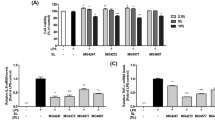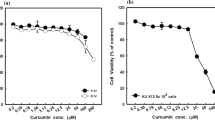Abstract
Selenium supplementation still enhanced the immune response even in individuals who, according to current standards, would be considered as not being overtly selenium deficient. Mast cells are granulated cells that play a pivotal role in allergic reactions. In this study, we investigated the modulatory effect of sodium selenite on mediator release and degranulation of murine mast cell line (MC/9). Cells were pre-treated with selenium selenite (1, 2, 3 μg/ml) for 24 h and controls left untreated. Then, cells were sensitized overnight with anti-dinitrophenyl (DNP) IgE and challenged with DNP/HSA for degranulation induction. The histamine and prostaglandin D2 (PGD2) were measured by ELISA, and β-hexosaminidase was measured by spectrophotometery method. Selenium-treated cells revealed significant decrease in concentration of PGD2 (P = 0.019) and β-hexosaminidase (P = 0.009). In addition, a slight reduction of histamine release by the selenium-treated cells was observed, based on our intracellular and extracellular assessments. The most inhibitory effect of selenium supplementation on mediator release of MC/9 cells was obtained in the presence of 3 μg/ml of sodium selenite. The results of the present study demonstrate beneficial effects of supplemental selenium in attenuating clinical manifestations of allergy and asthma.



Similar content being viewed by others
References
Kim SH, Johnson VJ, Shin TY, Sharma RP (2004) Selenium attenuates lipopolysaccharide-induced oxidative stress responses through modulation of p38 MAPK and NF-kappaB signaling pathways. Exp Biol Med (Maywood) 229(2):203–213
Broome CS, McArdle F, Kyle JA, Andrews F, Lowe NM, Hart CA, Arthur JR, Jackson MJ (2004) An increase in selenium intake improves immune function and poliovirus handling in adults with marginal selenium status. Am J Clin Nutr 80(1):154–162
Thomson CD, Wickens K, Miller J, Ingham T, Lampshire P, Epton MJ, Town GI, Pattemore P, Crane J (2012) Selenium status and allergic disease in a cohort of New Zealand children. Clin Exp Allergy 42(4):560–567. doi:10.1111/j.1365-2222.2012.03924.x
Matsui T, Suzuki Y, Yamashita K, Yoshimaru T, Suzuki-Karasaki M, Hayakawa S, Yamaki M, Shimizu K (2000) Diphenyleneiodonium prevents reactive oxygen species generation, tyrosine phosphorylation, and histamine release in RBL-2H3 mast cells. Biochem Biophys Res Commun 276(2):742–748. doi:10.1006/bbrc.2000.3545
Amin K (2012) The role of mast cells in allergic inflammation. Respir Med 106(1):9–14. doi:10.1016/j.rmed.2011.09.007
Kadrabova J, Mad’aric A, Kovacikova Z, Podivinsky F, Ginter E, Gazdik F (1996) Selenium status is decreased in patients with intrinsic asthma. Biol Trace Elem Res 52(3):241–248. doi:10.1007/BF02789165
Gueck T, Aschenbach JR, Fuhrmann H (2002) Influence of vitamin E on mast cell mediator release. Vet Dermatol 13(6):301–305
Guo CH, Liu PJ, Hsia S, Chuang CJ, Chen PC (2011) Role of certain trace minerals in oxidative stress, inflammation, CD4/CD8 lymphocyte ratios and lung function in asthmatic patients. Ann Clin Biochem 48(Pt 4):344–351. doi:10.1258/acb.2011.010266
Allan K, Devereux G (2011) Diet and asthma: nutrition implications from prevention to treatment. J Am Diet Assoc 111(2):258–268. doi:10.1016/j.jada.2010.10.048
Huang Z, Rose AH, Hoffmann PR (2012) The role of selenium in inflammation and immunity: from molecular mechanisms to therapeutic opportunities. Antioxid Redox Signal 16(7):705–743. doi:10.1089/ars.2011.4145
Vunta H, Belda BJ, Arner RJ, Channa Reddy C, Vanden Heuvel JP, Sandeep Prabhu K (2008) Selenium attenuates pro-inflammatory gene expression in macrophages. Mol Nutr Food Res 52(11):1316–1323. doi:10.1002/mnfr.200700346
Brooks AC, Whelan CJ, Purcell WM (1999) Reactive oxygen species generation and histamine release by activated mast cells: modulation by nitric oxide synthase inhibition. Br J Pharmacol 128(3):585–590. doi:10.1038/sj.bjp.0702838
Safaralizadeh R, Soheili ZS, Deezagi A, Pourpak Z, Samiei S, Moin M (2009) FcepsilonRI-alpha siRNA inhibits the antigen-induced activation of mast cells. Iran J Allergy Asthma Immunol 8(4):177–183
Hoffmann PR (2012) Asthma in children and nutritional selenium get another look. Clin Exp Allergy 42(4):488–489. doi:10.1111/j.1365-2222.2011.03949.x
Carneiro MF, Rhoden CR, Amantea SL, Barbosa F Jr (2011) Low concentrations of selenium and zinc in nails are associated with childhood asthma. Biol Trace Elem Res 144(1–3):244–252. doi:10.1007/s12011-011-9080-3
Wintergerst ES, Maggini S, Hornig DH (2007) Contribution of selected vitamins and trace elements to immune function. Ann Nutr Metab 51(4):301–323. doi:10.1159/000107673
Acknowledgments
This research has been supported by a grant from the Tehran University of Medical Sciences (grant code 88-04-40-10238).
Author information
Authors and Affiliations
Corresponding author
Rights and permissions
About this article
Cite this article
Safaralizadeh, R., Nourizadeh, M., Zare, A. et al. Influence of Selenium on Mast Cell Mediator Release. Biol Trace Elem Res 154, 299–303 (2013). https://doi.org/10.1007/s12011-013-9712-x
Received:
Accepted:
Published:
Issue Date:
DOI: https://doi.org/10.1007/s12011-013-9712-x




